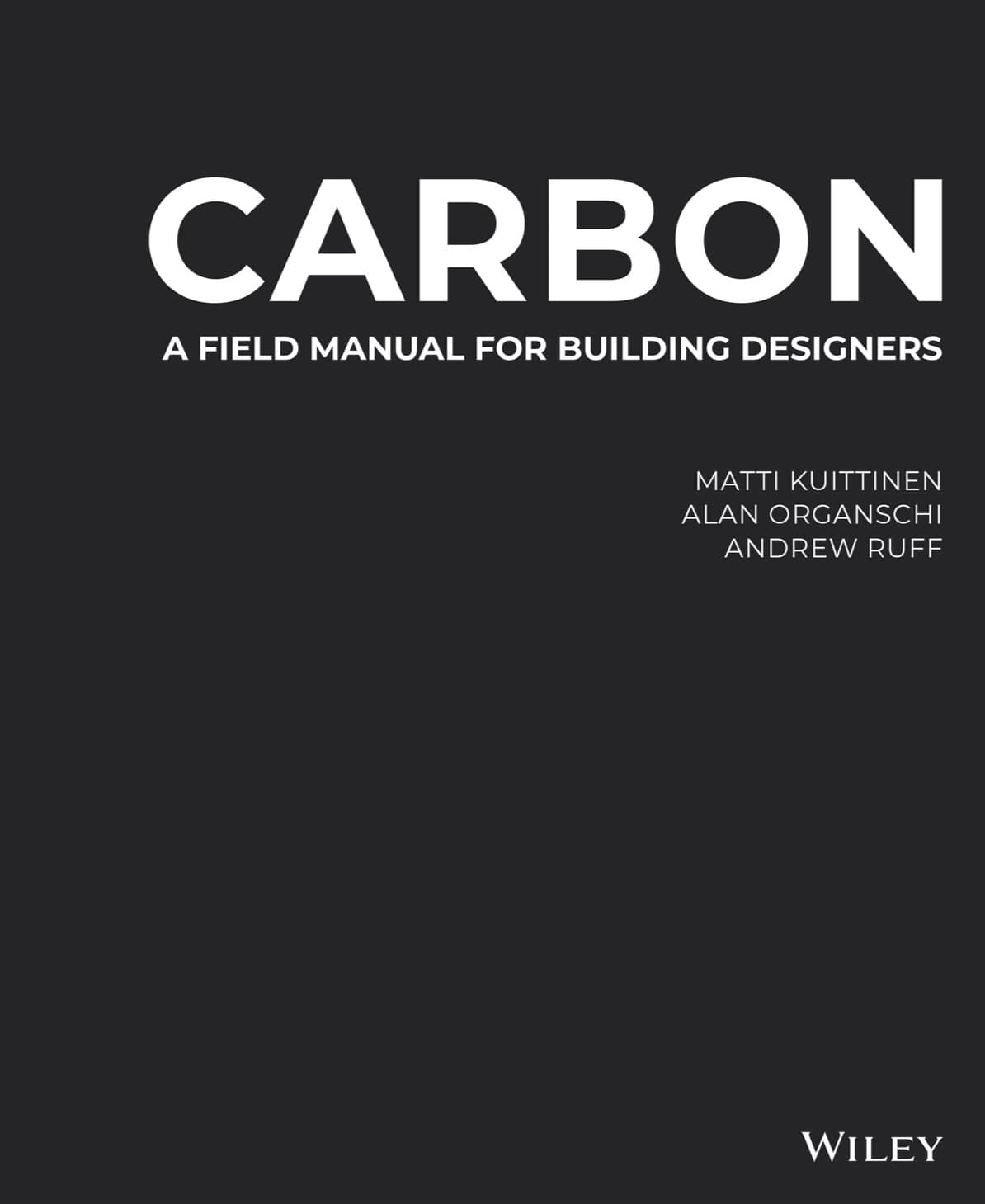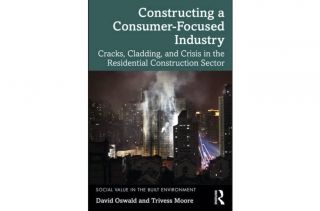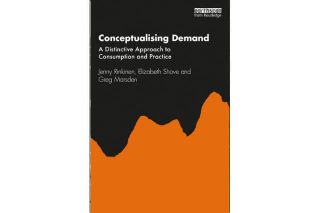
www.buildingsandcities.org/insights/reviews/carbon.html
CARBON: A Field Manual for Building Researchers
By Matti Kuittinen, Alan Organschi, Andrew Ruff. Wiley, 2022, ISBN 9781119720775
Francesco Pomponi applauds this significant book and recommends it as essential reading not only for researchers, but for policy makers, clients, construction professionals, educators and students.
A book for the 21st century

This is a must-read book. It achieves the rare outcome of being a successful volume for design practitioners (who should know what to do) as well as design students (who don't yet know what to do). But it is also very useful to educators, policymakers, engineers, local authorities, industry professionals and - really - anyone who takes seriously the sheer impacts caused by the global built environment to ecosystems, biodiversity, greenhouse gas (GHG) emissions, land use, urban fabric transformation, energy demand, social shifts and implications for the lives of millions who live in, or at the margins of, it.
This is probably the best book I have read in the field that successfully handles the complexity (chaos?) of building and construction. Every building that goes up has required an incredible amount of collaboration and interaction between architecture, engineering, industry, policy making, manufacturing, etc. This same complexity affects the carbon life of a building. Lacking an understanding of this interconnected nature, that crosses temporal and spatial borders, and expands globally in both space and time is what has significantly slowed down progress in tackling whole-life carbon of buildings in the last 20 years. Too many professions felt they were responsible for carbon more than other stakeholders in the value chain of a building, and too many others followed suit in thinking that a tool, a dataset, a method, a new material, would fix things.
Kuttinen, Organschi and Ruff manage to move away from it and to present a convincing argument to the reader as to why embracing this complexity is the only successful way forward. They acknowledge the role of the client as the entity that holds significant responsibility for determining the carbon footprint of a building, but they still root within architecture the fundamental agency for changing the status quo. Clients might impose the brief and particular demands, engineers might impose a certain structural approach or a material, but architecture does have that initiating agency that offers maximum potential for a successful outcome. So much so that we have known for quite some time that mitigating embodied carbon is best done as early as possible. However, life cycle assessments (LCAs) of built assets are often performed after an advanced and detailed design with the necessary material quantities that an LCA consultant needs. Thankfully technology is changing this, and I hope that new emerging solutions will scale up quickly to effect and maximise change.
The knowledge offered in the book on carbon is substantial, and many postgraduate students would benefit from it too (and of course, practitioners who weren't trained on these topics). Understanding the element of time management in carbon mitigation, presenting the concept of carbon payback period (although not explicitly mentioned, it is definitely there) as well as the comparative nature of LCA in evaluating design choices are all well understood by the authors and, most importantly, well explained. Current international standards in this space struggle to embed some of the concepts in this book (e.g. the importance of scenario analysis for the near or distant future), so it is encouraging to read a thoroughly prepared book that is fit for the challenges of our time.
While a whole-life approach is what most of the book focuses on, the authors have also given sufficient room to concepts that extend beyond the linearity of built assets as we understood (and assessed) them so far. A strong call to do everything we can in reusing and adapting existing buildings comes early in the book. This invites fresh thinking and action on how the design of new buildings and refurbs might expand and extend into the near- and mid-term. It is vital to anticipate the fast-paced nature of our economy and the continuous changes and shocks that our society experiences. The circular economy is presented as an inevitable (and desirable) way of bending the linear approach used so far. This is complemented by a brief review of useful design strategies, such as design for deconstruction, or for end-of-life; and the introduction of the philosophical nature of cradle-to-cradle. Although these concepts are not new, it's useful to have them connected in a book that is likely attract a wide audience. This thread of extending space and time continues in broadening the scope, agency and responsibility of decarbonising designs. The authors make a compelling case for looking upstream into the environmental resource flows of a global supply chain as well as downstream to the communities within, and the users of, the built environment.
No book can be perfect, so inevitably there are some areas where CARBON fell a bit short of expectations. For instance, while the authors acknowledge that each building is unique, they also suggest using intuition at early stages. While this might be appropriate in some cases, the tools and the data now exist (think of what Building Transparency has achieved in just a few years) that can support intuition. On the thread of numbers, the authors downplay the importance of upstream layers of the supply chain in identifying preferred alternatives when there's ample evidence that different alternatives might 'cross' preferential status when these upstream layers are considered through for instance a hybrid LCA.
This book surely makes for an enjoyable and interesting read - significantly enriched by the two case studies. These are extensive and sufficiently transparent to allow the 'study' to happen. The case studies in CARBON are robust and show that carbon outputs (in kg CO2e/m2) are much higher than what we think, when all main elements of a building are considered. This should be a red flag for all policymakers currently setting limit values that are too low, and risk encouraging incomplete and partial assessments for the sole purpose of compliance. From my perspective, it's better to start with larger numbers, and progressively ratchet downwards as our understanding increases of what 'good' looks like for different building types, structural systems, geographies, morphologies, materials.
This simple but powerful passage in the book is very refreshing:
"One of the greatest challenges in the design of a low-carbon building life cycle is that, in practice, all buildings are different."
The authors refrain from presenting any silver bullet to the climate crisis, and rather than offering solutions they offer a toolbox to navigate the choppy waters we are in. Even in their parting thoughts, the authors acknowledge that life cycle approach to building design is really only the starting point. Making the carbon economy circular and neutralising anthropogenic carbon are what we should aim for.
This book makes a compelling argument for moving the majority of architecture away from the visually spectacular and instead for developing a primary focus on the metabolic and ecological integration. This new role for architecture would eventually match the scope and depth of its agency, and perhaps bring it closer to architecture's original roots. It would also enable a new role for design education, where we stop teaching what 'sustainable' technologies are (i.e. offering answers) and instead teach the science that allows sustainability to be assessed (i.e. how to pose and answer questions). In today's academic world, a minor miracle is needed for this to happen, but hope is the one thing we can't lose. The authors encourage us all to build incrementally, with love and compassion as well as with intelligence and ingenuity. This sentence suits everything, not just the built environment. This book can be a useful companion for the journey of creating a better society.
Latest Peer-Reviewed Journal Content
A living lab approach to co-designing climate adaptation strategies
M K Barati & S Bankaru-Swamy
Mediation roles and ecologies within resilience-focused urban living labs
N Antaki, D Petrescu, M Schalk, E Brandao, D Calciu & V Marin
Negotiating expertise in Nepal’s post-earthquake disaster reconstruction
K Rankin, M Suji, B Pandey, J Baniya, D V Hirslund, B Limbu, N Rawal & S Shneiderman
Designing for pro-environmental behaviour change: the aspiration–reality gap
J Simpson & J Uttley
Lifetimes of demolished buildings in US and European cities
J Berglund-Brown, I Dobie, J Hewitt, C De Wolf & J Ochsendorf
Expanding the framework of urban living labs using grassroots methods
T Ahmed, I Delsante & L Migliavacca
Youth engagement in urban living labs: tools, methods and pedagogies
N Charalambous, C Panayi, C Mady, T Augustinčić & D Berc
Co-creating urban transformation: a stakeholder analysis for Germany’s heat transition
P Heger, C Bieber, M Hendawy & A Shooshtari
Placemaking living lab: creating resilient social and spatial infrastructures
M Dodd, N Madabhushi & R Lees
Church pipe organs: historical tuning records as indoor environmental evidence
B Bingley, A Knight & Y Xing
A framework for 1.5°C-aligned GHG budgets in architecture
G Betti, I Spaar, D Bachmann, A Jerosch-Herold, E Kühner, R Yang, K Avhad & S Sinning
Net zero retrofit of the building stock [editorial]
D Godoy-Shimizu & P Steadman
Co-learning in living labs: nurturing civic agency and resilience
A Belfield
The importance of multi-roles and code-switching in living labs
H Noller & A Tarik
Researchers’ shifting roles in living labs for knowledge co-production
C-C Dobre & G Faldi
Increasing civic resilience in urban living labs: city authorities’ roles
E Alatalo, M Laine & M Kyrönviita
Co-curation as civic practice in community engagement
Z Li, M Sunikka-Blank, R Purohit & F Samuel
Preserving buildings: emission reductions from circular economy strategies in Austria
N Alaux, V Kulmer, J Vogel & A Passer
Urban living labs: relationality between institutions and local circularity
P Palo, M Adelfio, J Lundin & E Brandão
Living labs: epistemic modelling, temporariness and land value
J Clossick, T Khonsari & U Steven
Co-creating interventions to prevent mosquito-borne disease transmission in hospitals
O Sloan Wood, E Lupenza, D M Agnello, J B Knudsen, M Msellem, K L Schiøler & F Saleh
Circularity at the neighbourhood scale: co-creative living lab lessons
J Honsa, A Versele, T Van de Kerckhove & C Piccardo
Positive energy districts and energy communities: how living labs create value
E Malakhatka, O Shafqat, A Sandoff & L Thuvander
Built environment governance and professionalism: the end of laissez-faire (again)
S Foxell
Co-creating justice in housing energy transitions through energy living labs
D Ricci, C Leiwakabessy, S van Wieringen, P de Koning & T Konstantinou
HVAC characterisation of existing Canadian buildings for decarbonisation retrofit identification
J Adebisi & J J McArthur
Simulation and the building performance gap [editorial]
M Donn
Developing criteria for effective building-sector commitments in nationally determined contributions
P Graham, K McFarlane & M Taheri
Join Our Community

The most important part of any journal is our people – readers, authors, reviewers, editorial board members and editors. You are cordially invited to join our community by joining our mailing list. We send out occasional emails about the journal – calls for papers, special issues, events and more.
We will not share your email with third parties. Read more



Latest Commentaries
COP30 Report
Matti Kuittinen (Aalto University) reflects on his experience of attending the 2025 UN Conference of the Parties in Belém, Brazil. The roadmaps and commitments failed to deliver the objectives of the 2025 Paris Agreement. However, 2 countries - Japan and Senegal - announced they are creating roadmaps to decarbonise their buildings. An international group of government ministers put housing on the agenda - specifying the need for reduced carbon and energy use along with affordability, quality and climate resilience.
Building-Related Research: New Context, New Challenges
Raymond J. Cole (University of British Columbia) reflects on the key challenges raised in the 34 commissioned essays for Buildings & Cities 5th anniversary. Not only are key research issues identified, but the consequences of changing contexts for conducting research and tailoring its influence on society are highlighted as key areas of action.